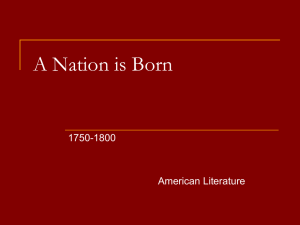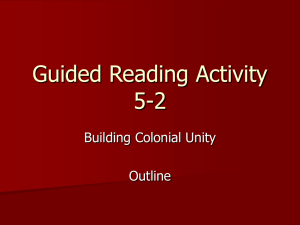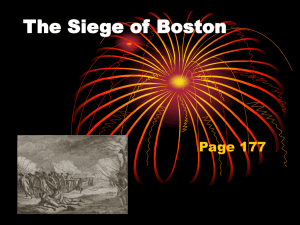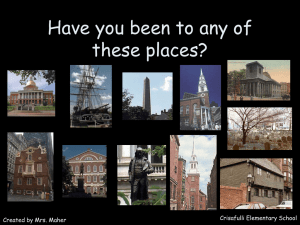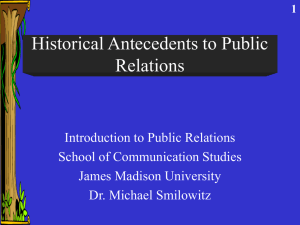City of Boston MIS Project
advertisement
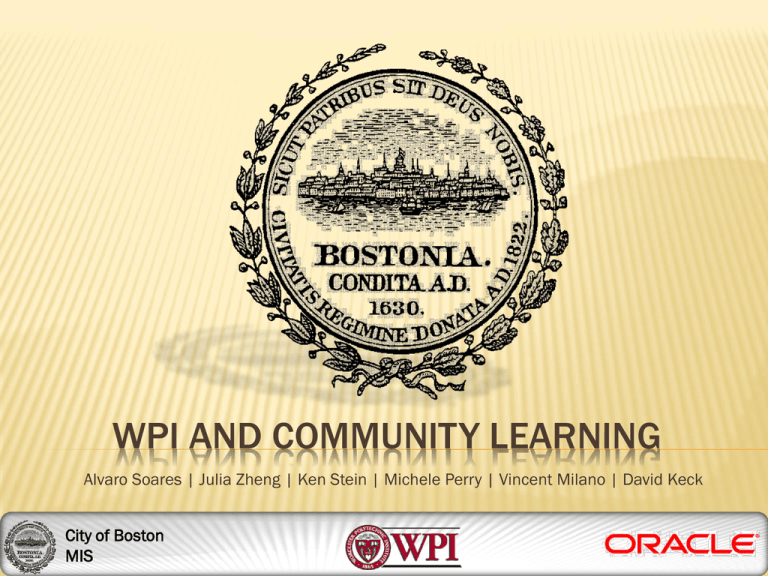
WPI AND COMMUNITY LEARNING Alvaro Soares | Julia Zheng | Ken Stein | Michele Perry | Vincent Milano | David Keck City of Boston MIS THE BIG PICTURE INTERESTING FACTS Our background research shows that: Students with no available Out-ofSchool programs miss valuable chances for growth and development (McLaughlin, 2000) More than half of the country’s teenagers wish there were more community-based programs available (Penn, Schoen & Berland Associates, 2001) As many as 15 million children with no after-school activities to attend nationwide (Miller, 1999) THE COMMUNITY LEARNING INITIATIVE “A new miracle…” – Mayor Thomas Menino A new push for a wellrounded education More after-school participation Institutionalize Boston’s main youth resources THE YOUTH ORGANIZATIONS BOSTON PUBLIC SCHOOLS BOSTON AFTER SCHOOL AND BEYOND BOSTON PUBLIC HEALTH COMMISSION BOSTON YOUTH LINE BOSTON PUBLIC LIBRARIES BOSTON CENTER FOR YOUTH AND FAMILIES OUT-OF-SCHOOL-TIME DOMAINS An after school program provides students with activities that will enhance the student’s proficiency in various domains Most important domains outlined in ACES framework adopted by BCYF WPI INVOLVEMENT PROGRAMS: GOALS Make youth information accessible Connect current databases Gather data from other programs Utilize data by preventing duplication YOUTH: GOALS METHODOLOGY Developed: Analyzed: A Current potential after-school solution for a Compiled a list of existing information data model and systems devised a systems that could be Identified Studied Mapped the the potential possibility geographical links ofthe recommendation for Investigated organization’s implemented and among finding involvement a the correlation systems of students and between infor most feasible solution expectations determined which software determined after-school the involvement programs efficiency and of a new system current system systems fulfill the in place the academic current performance systems A recommendation system used to measure program requirements for different use cases efficiency DISCUSSING DIFFICULTIES Multi-level data privacy System compatibility Monetary investment Social/behavioral correlations difficult to be considered valid, because of too many external factors FINDINGS GIS MAPS GIS maps inconclusive due to lack of programmatic data that is not being collected or is incomplete FINDINGS Students who participate in after-school programs are less likely to drop out more likely to have higher academic achievement (Theory Into Practice, 2004; ERIC Digest, 2001 ) Delinquency in students can be decreased when after-school programs are regularly attended. (Prevention Science, 2004; Theory and Practice, 2004; ERIC Digest, 2001) FINDINGS Programs that encourage achievement and build self esteem are more likely to increase grades than ones that give extended homework time (ERIC Digest, 2001; Prevention Science, 2004; Theory and Practice 2004) Activities that take up too much of the students’ time can detract from homework and cause a decrease in grades (Theory Into Practice, 2004; ERIC Digest, 2001) FINDINGS Each organization has different use for the data collected Some databases are not being updated Performance metrics poorly recorded FINDINGS Website reports that average user spends 6-9 seconds on the website Updating system is complicated and organizations are not updating the system often enough, if at all MAPPING THE FUTURE ANALYSIS: THE IDEAL SOLUTION Our system needs to: Be accessible to all organizations Track performance metrics Be flexible and easily customizable Be user friendly Cost-effective ANALYSIS: PERFORMANCE METRICS The system needs to accommodate different key metrics for different organizations A VISION OF THE FUTURE THE LEARNING PLATFORM FINDINGS: ONE-CARD IMPLEMENTATION Boston In the future Main the Streets afterschool has implemented card systems a couldthat card be integrated gives with the MBTA, cardholders discounts Community in local businesses. Change, and BPS. Community Change is eager BPS isto piloting co-brand a with program other organizations with MBTA in the near future Boston. COMPARING ALTERNATIVES FINDINGS: POSSIBLE ALTERNATIVES CitySpan Successfully in use by several other cities which BPS would like to emulate, such as: Providence Chicago FINDINGS: POSSIBLE ALTERNATIVES Cayen Used in 10 PSS Schools in Boston Finger scanning software Used in: South Carolina Kentucky Integrate qualitative and quantitative metrics Customizable within city’s organizations Data warehousing FINDINGS: POSSIBLE ALTERNATIVES KidTrax In use by 16 high schools and 22 organizations in the City of Boston already Has an integrated card system Flexible system, capable of generating reports COMPARING SYSTEMS ANALYSIS: RUBRIC SAMPLE ANALYSIS: COMPARING PROGRAMS We weighted and compared each alternative to rank them according to their attributes. COST COMPARISON We requested a high-level basic quote from nFocus, Cityspan, and Cayen. The following are 3 year cost estimates CHOOSING A SOLUTION FOR BOSTON RECOMMENDATION: CITYSPAN We feel that Cityspan’s Youthservices.net is the most feasible information system for Boston’s Community Learning Initiative Key attributes Quickest learning curve Comparatively Inexpensive Thorough reports Fastest system RECOMMENDATION: CITYSPAN The following issues need to be addressed: Period of installation Security and privacy Data storage Compatibility with organizations that already use a different system CATALOGUING PROGRAMS RECOMMENDATION 2: NAVIGATOR STRUCTURE After gathering data, we have developed several use cases We developed a recommendation that is tailored to each use case www.BOSTONavigator.com RECOMMENDATION 3: SEARCH CRITERIA Soccer Reading Neighborhood Forums Basketball Math T-Stops Conferences Football Test Scores Volleyball RECOMMENDATION 4: INTRODUCING A COMMUNITY LEARNING ROLE PROJECT IMPACT SUMMARY A unified back-end system will allow for Boston Youthline to function to its full potential. Government will shift its policy making strategy from processdriven to data-driven. WPI’s involvement has created awareness and visibility into Community Learning The front-end user and organizations will have direct interaction by improving BOSTONavigator. Trends and correlations will be more easily made than ever, with performance tracks being measured immediately and constantly. SOLUTION: A SEAMLESS INTERACTION BOSTON PUBLIC SCHOOLS BOSTON AFTER SCHOOL AND BEYOND BOSTON PUBLIC LIBRARIES BOSTON CENTER FOR YOUTH AND FAMILIES BOSTON PUBLIC HEALTH COMMISSION BOSTON YOUTHLINE ACKNOWLEDGEMENTS We would like to express our gratitude towards the following collaborators and their respective organizations Nigel Jacob – Senior Advisor for Emerging Technologies, City of Boston Chris Breining – Insight Program Director, Oracle Corporation Boston MIS Department Bill Oates Boston Youthline Patty McMahon Boston Public Libraries Ruth Kowal Koren Stembridge Scot Colford John Dorsey Ken Peterson BCYF Amy Reid Daphne Griffin PASA (Providence After-school Alliance) Elizabeth Devaney Boston After School and Beyond Vickie Stringfellow Patricia McGuiness Boston’s GIS Group Claire Lane Jim Alberque Carolyn Bennet Oracle Corporation Paul Laurent Boston Public Health Commission Michelle Urbano Jeanne Cannata Boston Youth Services Network Heidi Hall BPS Shamil Mohammed Kenneth Still Wallace Johnson Alice Santiago Kim Rice QUESTIONS?

